Sustainability in Infrastructure Project Management—Analysis of Two European Megaprojects
Abstract
1. Introduction
2. Significance and Methodology
2.1. Research Background
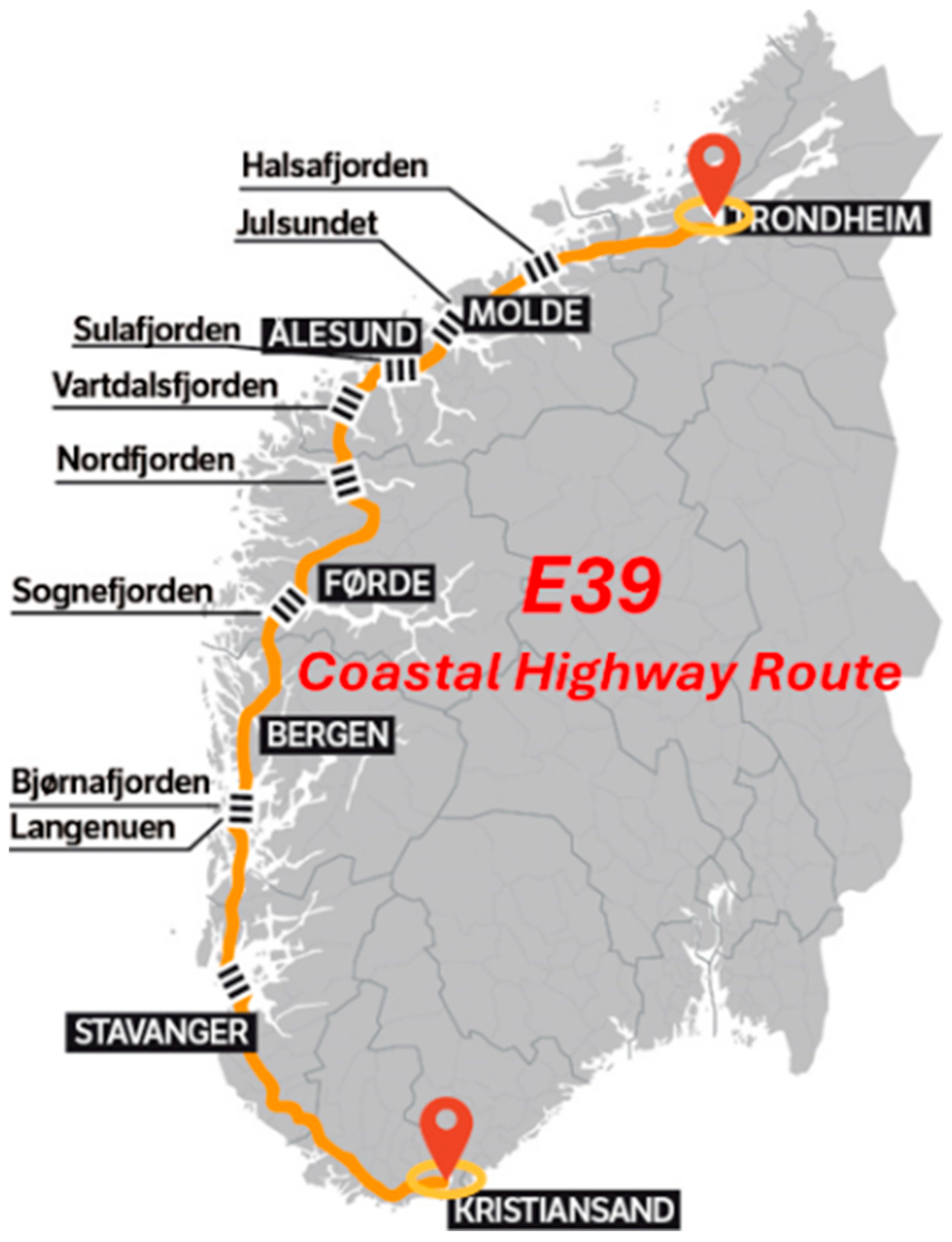
2.2. Megaprojects Description
2.2.1. A16 Rotterdam Project
2.2.2. Fehmarnbelt Tunnel Project
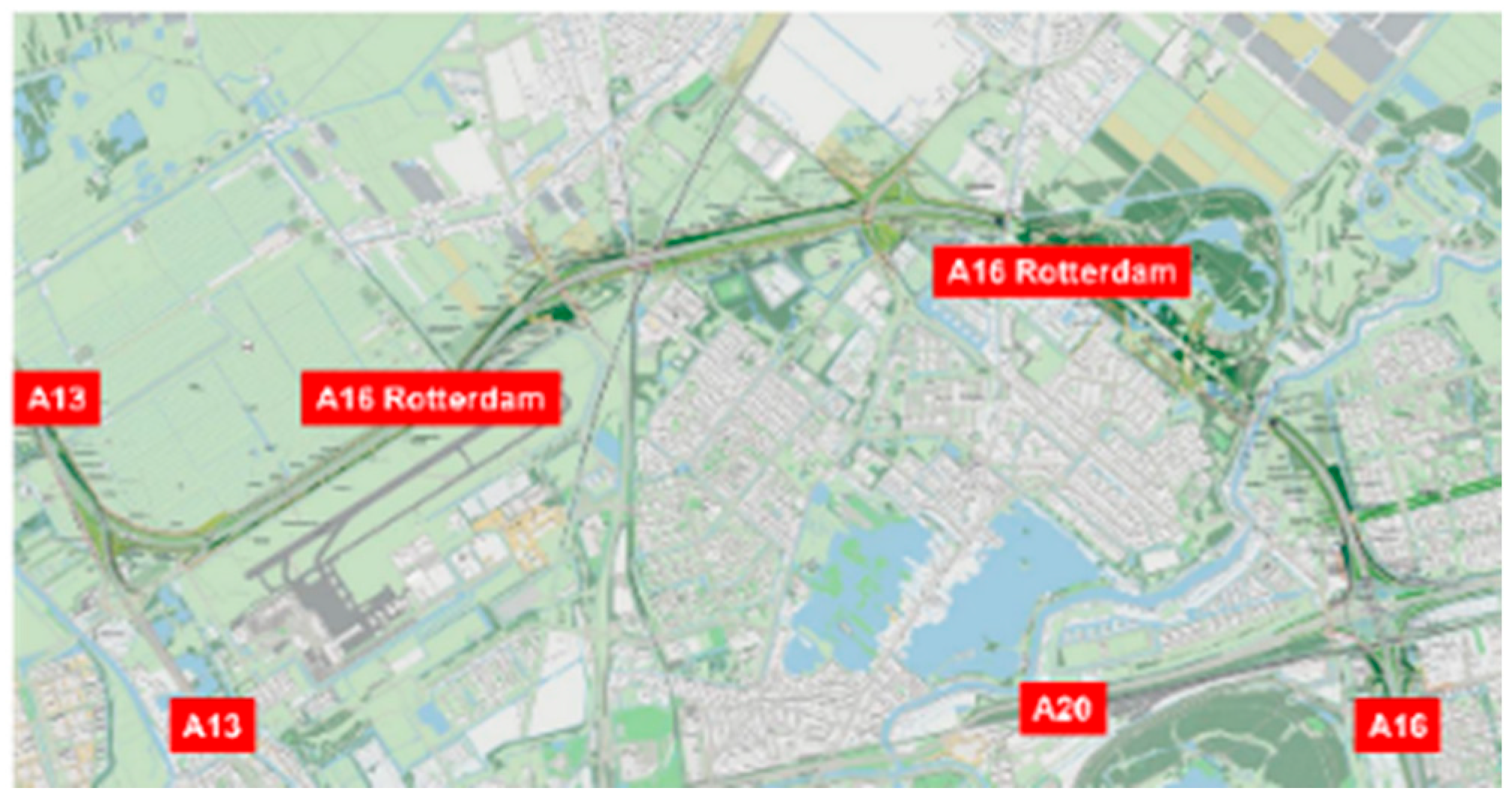
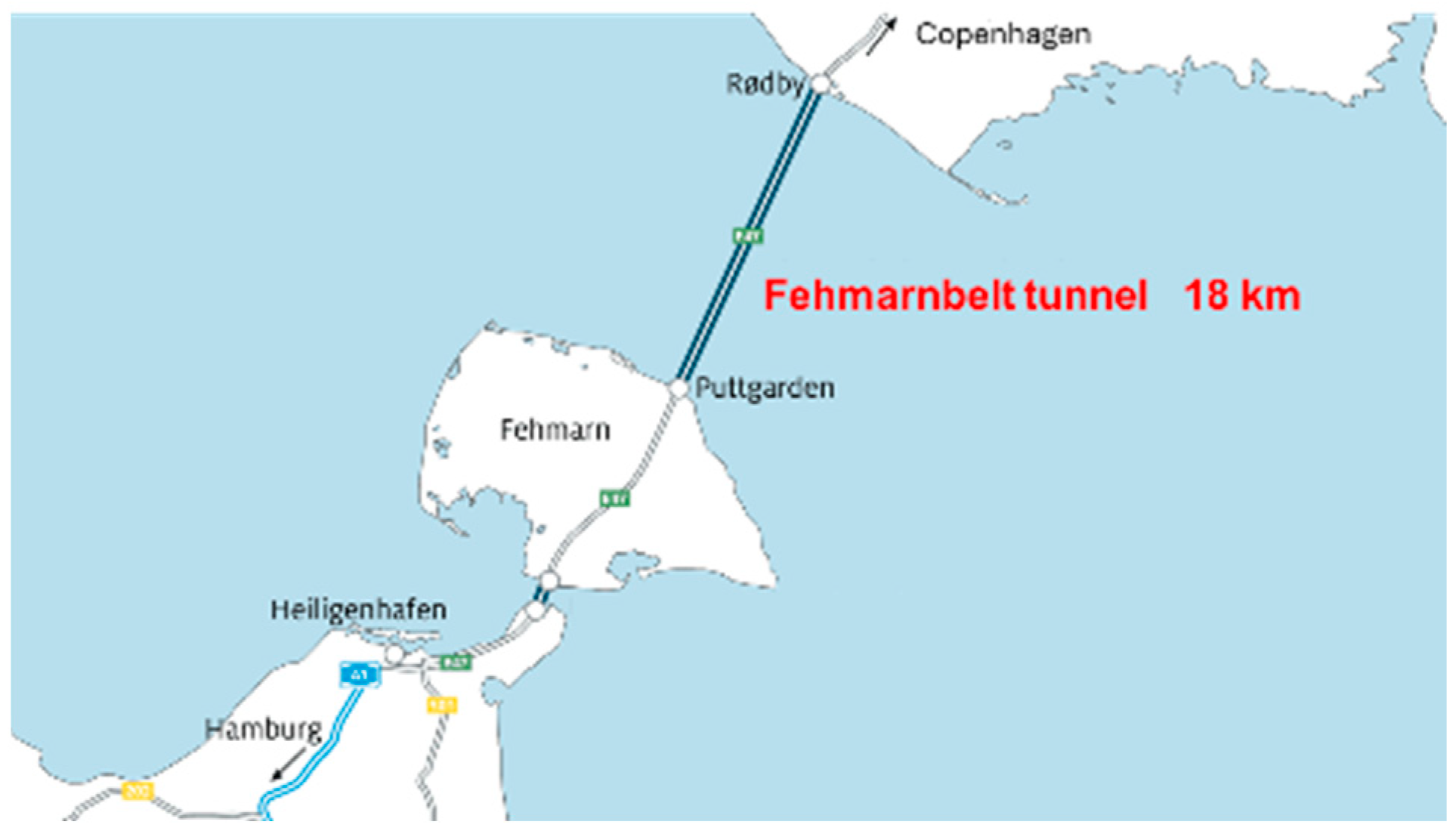
| PROJECT NAME | A16 ROTTERDAM PROJECT | FEHMARNBELT TUNNEL PROJECT |
|---|---|---|
| Location | Rotterdam, the Netherlands | Lolland, Denmark Fehmern, Germany |
| Contractors | De Groene Boog (BESIX, Dura Vermeer, Van Oord, John Laing, Rebel and TBI) | Fehmarn Belt Contractors (FBC) and Fehmarn Link Contractors (FLC) |
| Length | 11 km | 18 km |
| Investment | EUR 984 million | EUR 7100 million |
| Construction schedule | 2019–2025 | 2021–2029 |
| Operating speed | 100 km/h | 200 km/h |
| Infrastructure type | Highway, tunnel, railway | Highway, railway |
| Highlights | First energy-neutral highway tunnel worldwide | Longest immersed tunnel worldwide |
| Objective | Improve traffic flow and accessibility in the Rotterdam region | Enhance transport connectivity between Scandinavia and central Europe |
3. Sustainable Measures in Megaprojects
3.1. A16 Rotterdam Project
3.1.1. Energy Saving Measures
3.1.2. Carbon Evaluation Method
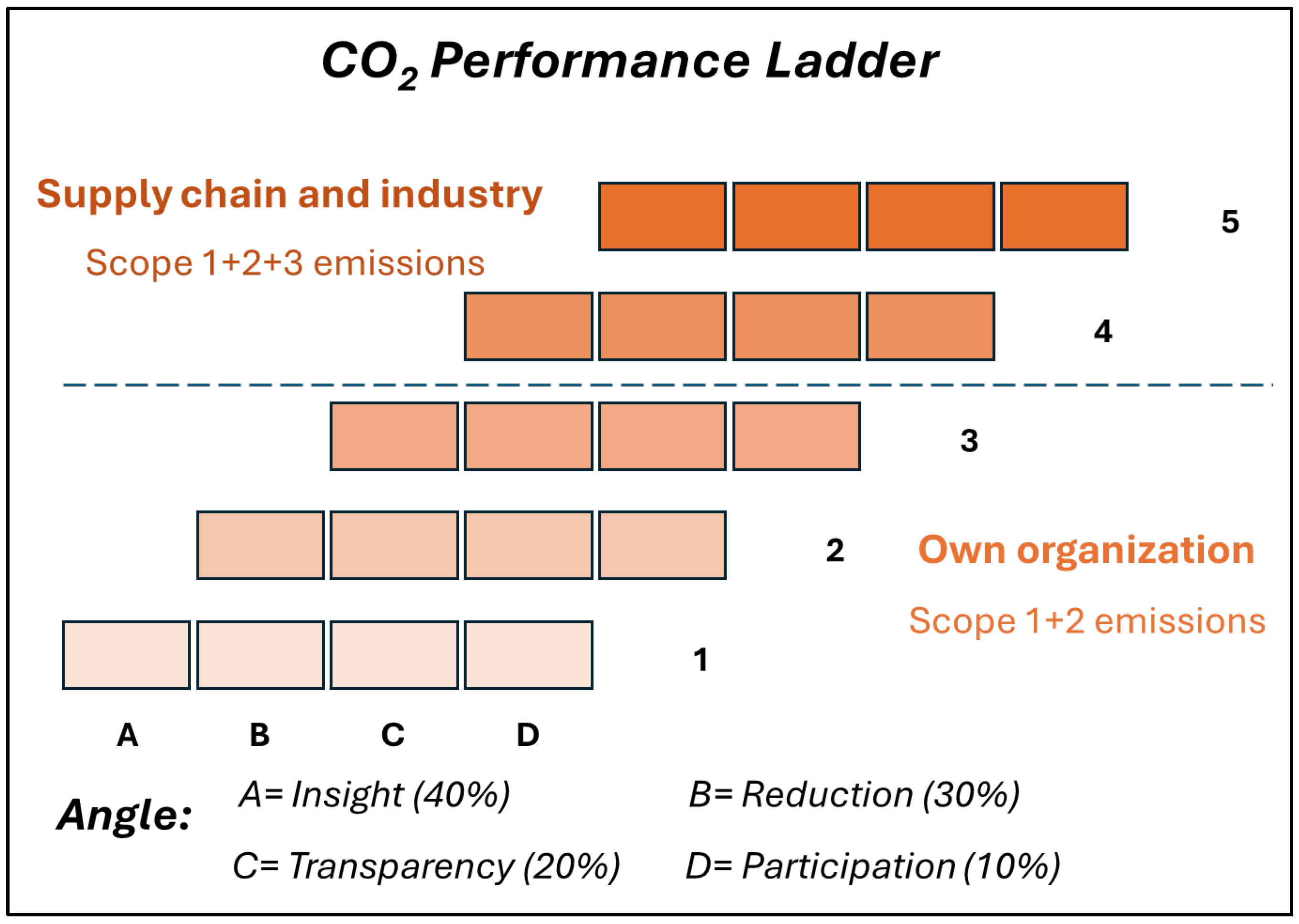
3.2. Fehmarnbelt Tunnel Project
3.2.1. Energy Saving Measures
3.2.2. Carbon Evaluation Method
| PLACE | TYPE | AFFECTED NATURE | NEW NATURE TO BE ESTABLISHED | NEW NATURE ESTABLISHED (UNTIL 2023) |
|---|---|---|---|---|
| LOLLAND | Ponds | 10 | 37–42 | 20 |
| Beach/meadow/ dry grassland | 29.2 ha | 116.9 ha | 58.4 ha | |
| Marsh | 0.5 ha | 1.5 ha | 1.5 ha | |
| Watercourses | 3.3 km | 3.3 km | 2.6 km | |
| FEHMARN | Stone reefs | 42.5 ha | – | |
| Areas taken out of intensive farming | 172.5 ha | 172.5 ha | ||
| Other compensation measures | – | 51.5 ha |

4. Results and Discussion
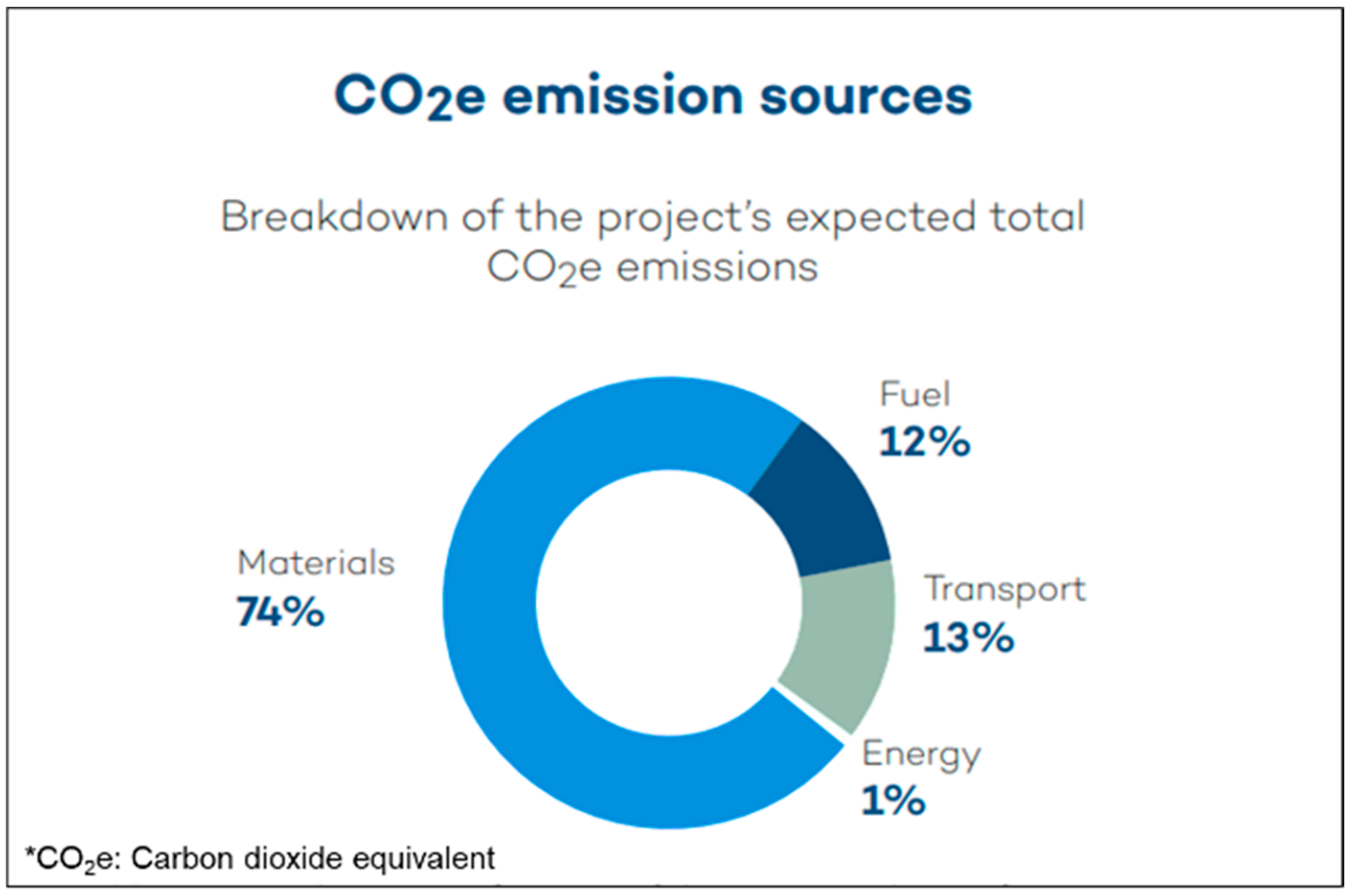
5. Conclusions
Author Contributions
Funding
Data Availability Statement
Conflicts of Interest
References
- European Commission, Climate Action and the Green Deal. 2025. Available online: https://commission.europa.eu/strategy-and-policy/priorities-2019-2024/european-green-deal/climate-action-and-green-deal_en (accessed on 1 May 2025).
- Wiedenhofer, D.; Baumgart, A.; Matej, S.; Virág, D.; Kalt, G.; Lanau, M.; Tingley, D.D.; Liu, Z.; Guo, J.; Tanikawa, H.; et al. Mapping and modelling global mobility infrastructure stocks, material flows and their embodied greenhouse gas emissions. J. Clean. Prod. 2024, 434, 139742. [Google Scholar] [CrossRef]
- Laurance, W.F.; Clements, G.R.; Sloan, S.; O’Connell, C.S.; Mueller, N.D.; Goosem, M.; Venter, O.; Edwards, D.P.; Phalan, B.; Balmford, A.; et al. A global strategy for road building. Nature 2014, 513, 229–232. [Google Scholar] [CrossRef] [PubMed]
- Roxas, N.R.; Roquel, K.I.D.Z.; Yu, K.D.S.; Ruiz, A.E.C.; Fillone, A.M. Infrastructure impacts calculator: An infrastructure assessment tool using co-benefit approach. Int. J. GEOMATE 2023, 24, 101–108. [Google Scholar] [CrossRef]
- Malaise, J.; Rohse, M.; Foulds, C.; Loewen, B.; Crowther, A. Citizen-Led Recommendations for the Horizon Europe Missions on sustainability; SSH CENTRE: Cambridge, UK, 2024; Available online: https://hdl.handle.net/11250/3184235 (accessed on 1 May 2025).
- DISCOVER, DISCOVER. 2025. Available online: https://discover-horizon.eu/project/ (accessed on 1 May 2025).
- CIRC-2-ZERO, CIRC-2-ZERO. 2025. Available online: https://www.hamk.fi/en/projects/circ-2-zero/ (accessed on 1 May 2025).
- Kidd, C. V The evolution of sustainability. J. Agric. Environ. Ethics 1992, 5, 1–26. [Google Scholar] [CrossRef]
- Lima, L.; Trindade, E.; Alencar, L.; Alencar, M.; Silva, L. Sustainability in the construction industry: A systematic review of the literature. J. Clean. Prod. 2021, 289, 125730. [Google Scholar] [CrossRef]
- Flyvbjerg, B. The Oxford Handbook of Megaproject Management; Oxford University Press: Oxford, UK, 2024. [Google Scholar]
- Dyllick, T.; Hockerts, K. Beyond the business case for corporate sustainability. Corp. Environ. Responsib. 2002, 11, 81–141. [Google Scholar] [CrossRef]
- Green Project Management, Green Project Management. 2025. Available online: https://gpm.org/ (accessed on 1 May 2025).
- CEN ISO 21931-1; Sustainability in Buildings and Civil Engineering Works. Framework for Methods of Assessment of the Environmental, Social and Economic Performance of Construction Works as a Basis for Sustainability Assessment. Buildings. European Committee for Standardization: Brussels, Belgium, 2022.
- IPCC. AR6 Synthesis Report: Climate Change 2023; IPCC: Geneva, Switzerland, 2023. [Google Scholar] [CrossRef]
- Dunham, K.K. Coastal highway route E39—Extreme crossings. Transp. Res. Procedia 2016, 14, 494–498. [Google Scholar] [CrossRef][Green Version]
- Barbieri, D.M.; Hoff, I.; Mork, H. Laboratory investigation on unbound materials used in a highway with premature damage. In Proceedings of the 10th International Conference on the Bearing Capacity of Roads, Railways and Airfields, Athens, Greece, 28–30 June 2017; Loizos, A., Al-Qadi, I.L., Scarpas, A.T., Eds.; Taylor & Francis: Athens, Greece, 2017; pp. 101–108. [Google Scholar] [CrossRef]
- Global Railway Review, Can Norway Build the World’s First Submerged Floating Tube Bridge? 2024. Available online: https://www.globalrailwayreview.com/?utm_medium=referral&utm_source=intelligenttransport.com (accessed on 1 May 2025).
- GWW-Bouw, A16 Rotterdam Writes History for Rotterdam and the Surrounding Area. Available online: https://gww-bouw.nl/wegenbouw/infraproject-a16-rotterdam-schrijft-geschiedenis-voor-rotterdam-en-omstreken/ (accessed on 1 May 2025).
- ADAC, Fehmarnbelt Tunnel: Direct from Hamburg to Copenhagen in 2029. 2024. Available online: https://www.adac.de/news/fehmarnsundtunnel/ (accessed on 1 May 2025).
- A16 Rotterdam, A16 Rotterdam: The New Highway Between the A13 and the A16. 2024. Available online: https://a16rotterdam.nl/home/default.aspx (accessed on 1 May 2025).
- ARUP, Fehmarnbelt Immersed Tunnel to Link Denmark to Germany in Northern Europe’s Largest Infrastructure Project. 2024. Available online: https://www.arup.com/projects/fehmarnbelt-fixed-link/ (accessed on 1 May 2025).
- ARUP, Decarbonisation. 2024. Available online: https://www.arup.com/services/decarbonisation/ (accessed on 1 May 2025).
- BESIX, A16 Rotterdam: World’s First Energy-Neutral Highway. 2024. Available online: https://annualreport.besix.com/wp-content/uploads/2020/05/P13-Concessions-Assets-A16-Rotterdam-NDL.pdf (accessed on 1 May 2025).
- BESIX, A16: De Groene Boog. A New Motorway and an Energy-Neutral Tunnel. 2025. Available online: https://www.besix.com/en/projects/a16-de-groene-boog (accessed on 1 May 2025).
- Bechauf, R.; Turley, L.; Casier, L. The CO2 Performance Ladder as a Tool for Low-Carbon Procurement; Aramco: Dhahran, Saudi Arabia, 2023. [Google Scholar]
- Schep, E.; Bachaus, A.; Bijleveld, M.; Deen, M. Evaluation CO2 Performance Ladder; Aramco: Delft, The Netherlands, 2022. [Google Scholar]
- Femern, Sustainability Report 2023. 2024. Available online: https://femern.com/media/hhmhmg2b/femern_sustainability_report_2023_uk_final_highres.pdf (accessed on 1 May 2025).
- Cornet, Y.; Dudley, G.; Banister, D. High speed rail: Implications for carbon emissions and biodiversity. Case Stud. Transp. Policy 2018, 6, 376–390. [Google Scholar] [CrossRef]
- Brock, A. A green extractivist railway? Exploring the political ecology of Europe’s largest infrastructure project. J. Polit. Ecol. 2024, 31, 488–515. [Google Scholar] [CrossRef]
- DHI, An Environmental Portal for the Fehmarnbelt Tunnel Project. 2024. Available online: https://www.dhigroup.com/projects/an-environmental-portal-for-the-fehmarnbelt-tunnel-project (accessed on 1 May 2025).
- Barbieri, D.M.; Hoff, I.; Mørk, M.B.E. Mechanical assessment of crushed rocks rerived from tunnelling operations. In Sustainable Civil Infrastructures; Cheng, W.-C., Yang, J., Wang, J., Eds.; Springer: Hangzhou, China, 2019; pp. 225–241. [Google Scholar] [CrossRef]
- Lou, B.; Barbieri, D.M.; Bohne, R.A. BIM-based life cycle assessment to quantify carbon dioxide emissions during road construction. In Proceedings of the 5th International Conference on Transportation Geotechnics (ICTG) 2024, Volume 7; Rujikiatkamjorn, C., Xue, J., Indraratna, B., Eds.; Springer: Singapore, 2024; pp. 403–412. [Google Scholar] [CrossRef]
- Lou, B.; Rasmussen, F.N.; Degago, S.A.; Juvik, E.S.; Bohne, R.A. A BIM-based carbon footprinting of earthworks in road construction process. Environ. Impact Assess. Rev. 2025, 110, 107731. [Google Scholar] [CrossRef]
- Barbieri, D.M.; Lou, B.; Passavanti, M.; Hui, C.; Lessa, D.A.; Maharaj, B.; Banerjee, A.; Wang, F.; Chang, K.; Naik, B.; et al. Survey data regarding perceived air quality in Australia, Brazil, China, Ghana, India, Iran, Italy, Norway, South Africa, United States before and during COVID-19 restrictions. Data Br. 2020, 32, 106169. [Google Scholar] [CrossRef] [PubMed]
- Aparicio, Á. The changing decision-making narratives in 25 years of TEN-T policies. Transp. Res. Procedia 2017, 25, 3715–3724. [Google Scholar] [CrossRef]
- Van Weenen, R.L.; Burgess, A.; Francke, J. Study on the implementation of the TEN-T regulation—The Netherlands case. Transp. Res. Procedia 2016, 14, 484–493. [Google Scholar] [CrossRef][Green Version]
- Federal Ministry for Digital and Transport, Fehmarnbelt Fixed Link. 2025. Available online: https://bmdv.bund.de/EN/Topics/EU-Policy/EU-Transport-Policy/Fehmarnbelt/fehmarnbelt-fixed-link.html?utm_source=chatgpt.com (accessed on 1 May 2025).
- Lucarelli, C.; Mazzoli, C.; Rancan, M.; Severini, S. Classification of sustainable activities: EU taxonomy and scientific literature. Sustainability 2020, 12, 6460. [Google Scholar] [CrossRef]
- Sha, A.; Jiang, W.; Wang, W.; Lou, B.; Cao, Y.; Jia, M. Design and prospect of new pavement materials for smart road. Chinese Sci. Bull. 2020, 65, 3259–3269. [Google Scholar] [CrossRef]
- Miljøpakken, Elektrisk Veg–Pilotprosjekt. 2024. Available online: https://miljopakken.no/prosjekter/elektrisk-veg-pilotprosjekt (accessed on 1 May 2025).
- Tinti, F.; Boldini, D.; Ferrari, M.; Lanconelli, M.; Kasmaee, S.; Bruno, R.; Egger, H.; Voza, A.; Zurlo, R. Exploitation of geothermal energy using tunnel lining technology in a mountain environment. A feasibility study for the Brenner Base tunnel—BBT. Tunn. Undergr. Sp. Technol. 2017, 70, 182–203. [Google Scholar] [CrossRef]
- Flor, A.; Sassi, F.; La Morgia, M.; Cernera, F.; Amadini, F.; Mei, A.; Danzi, A. Artificial intelligence for tunnel boring machine penetration rate prediction. Tunn. Undergr. Sp. Technol. 2023, 140, 105249. [Google Scholar] [CrossRef]
Disclaimer/Publisher’s Note: The statements, opinions and data contained in all publications are solely those of the individual author(s) and contributor(s) and not of MDPI and/or the editor(s). MDPI and/or the editor(s) disclaim responsibility for any injury to people or property resulting from any ideas, methods, instructions or products referred to in the content. |
© 2025 by the authors. Licensee MDPI, Basel, Switzerland. This article is an open access article distributed under the terms and conditions of the Creative Commons Attribution (CC BY) license (https://creativecommons.org/licenses/by/4.0/).
Share and Cite
Lou, B.; Afshari, M.; Johansen, A.; Nygaard Rasmussen, F.; Bohne, R.A. Sustainability in Infrastructure Project Management—Analysis of Two European Megaprojects. Infrastructures 2025, 10, 113. https://doi.org/10.3390/infrastructures10050113
Lou B, Afshari M, Johansen A, Nygaard Rasmussen F, Bohne RA. Sustainability in Infrastructure Project Management—Analysis of Two European Megaprojects. Infrastructures. 2025; 10(5):113. https://doi.org/10.3390/infrastructures10050113
Chicago/Turabian StyleLou, Baowen, Mahgol Afshari, Agnar Johansen, Freja Nygaard Rasmussen, and Rolf André Bohne. 2025. "Sustainability in Infrastructure Project Management—Analysis of Two European Megaprojects" Infrastructures 10, no. 5: 113. https://doi.org/10.3390/infrastructures10050113
APA StyleLou, B., Afshari, M., Johansen, A., Nygaard Rasmussen, F., & Bohne, R. A. (2025). Sustainability in Infrastructure Project Management—Analysis of Two European Megaprojects. Infrastructures, 10(5), 113. https://doi.org/10.3390/infrastructures10050113






